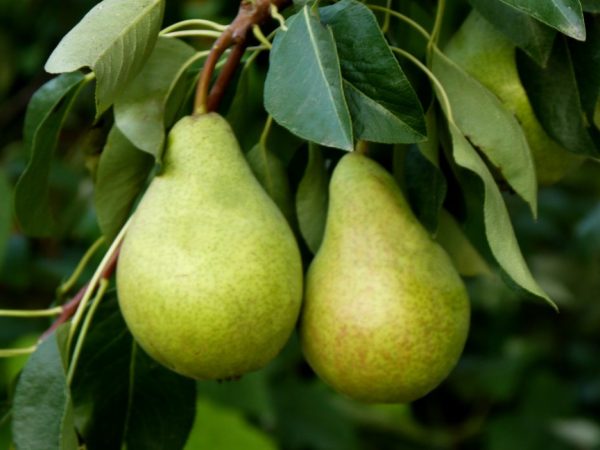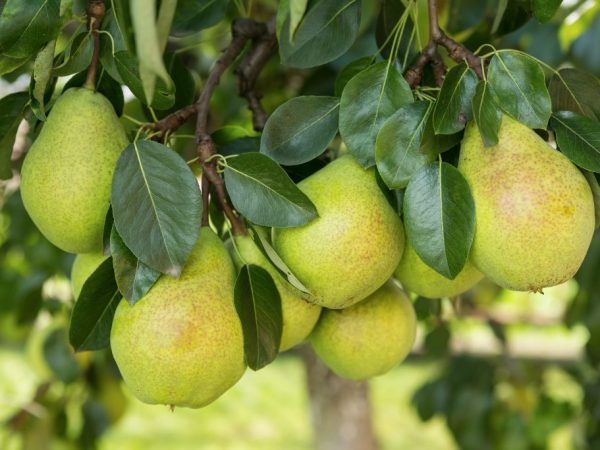Characteristics of the pear variety Victoria
Pear Victoria is a hybrid obtained by crossing the Talgar beauty and the Daughter of Dawn.

Characteristics of the pear variety Victoria
Variety characteristic
Pear Victoria - winter culture. The variety is slow-growing (begins to bear fruit 5-6 years after planting), high-yielding.
The advantages of the variety:
- disease resistance;
- high frost resistance.
Description of the tree
Pear variety Victoria belongs to the combined type of fruiting. According to the description, the plant is vigorous. The crown grows in the shape of an oval, has an average density. The disadvantages include the large height of the trunk. The foliage is smooth in structure, rounded, shortly pointed.
Description of the fetus
The fruits ripen closer to mid-September. At cool temperatures, they lie for 120 to 150 days.
Fruits are medium to large. Their mass is from 125 to 210 g. The pear shape is elongated. The skin is of medium thickness, with a waxy coating. During the ripening period, the fruits acquire a yellowish color. Despite the autumn season and the coming coolness, pears are very juicy, with a sweet and sour aftertaste and delicate aroma.
This variety lacks granulation and astringency. The pulp is snow-white, with a light creamy shade. The fruit is hypoallergenic, so it is permissible to make porridge from it for babies from 6 months.
Care
Landing
It is best to plant this variety in the fall.
When planting, be sure to choose loose soil. Victoria loves moisture in the roots, but withers away from too humid air. The land is pre-saturated with minerals and natural fertilizers. To do this, mix the soil dug out of the pit with rotted manure, peat or compost. Also, the quality of the soil will be significantly improved by mineral potash-phosphorus fertilizers, wood ash will loosen the soil well.
It is better to choose a place for a seedling in the south or west, but so that the crown does not take on all the sunlight.
Watering

The tree needs to be watered as needed
The amount of water required by a pear is equal to several irrigations in spring and summer. In severe drought, more often. The main rule is not to flood the soil near the trunk. The plant is watered under the crown, thereby preventing loosening at the root. Watering rate - 3 buckets per 1 sq. m of the near-stem area.
Mulching
Mulching prevents excessive evaporation of moisture, the growth of weeds and the reproduction of pests, and retains moisture. To do this, you can use sawdust, straw or pine needles. The procedure is carried out in the spring.
The roots are kept warm in winter by covering them with a large layer of snow, leaves or straw.
Loosening
It is advisable to loosen it several times during the summer, especially after watering. This allows the soil to breathe and allow air to flow to the roots and also prevents weeds from growing. It is best to use a hoe or hoe. In order not to damage the roots, they do not loosen very deeply.
Fertilization
You can start fertilizing in the second year after planting. This is best done in the fall or spring. Mineral fertilizers are applied every year, and organic fertilizers are applied every 3 years.To do this, a trench is dug around the tree. On average, 1 sq. m account for 25 g of potassium chloride, 9-10 kg of humus and 14 g of urea. The trench has the advantage of digging in that useful substances evaporate from it much more slowly, remaining in the soil.
Pruning
The first pruning is carried out immediately after planting. The roots can be damaged, weakening the seedling, so the branches are shortened.
After a year of growth, cut off 25% of the trunk (top) of the total length in order to branch the crown. Lateral shoots are also shortened, but only to the first bud.
In subsequent years of the tree's life, the top (by 25-30 cm) and side branches (by 6-10 cm) are cut off. Thus, a tree is formed in the form of a pyramid, leaving the lower branches longer and the upper ones shorter. This improves the yield.
Diseases and pests
The advantage of the Victoria variety is disease resistance, but improper care and unforeseen weather conditions can lead to the occurrence of an illness.
The most common diseases:
- scab;
- bacterial burn;
- fruit rot.
They most often appear as brown spots on the leaves and fruits. If the affected fruit or leaves are visible, they should be torn off, and at the end of autumn, the fallen leaves should be removed and burned so as not to spread the infection.
Comprehensive treatment of wood against pests in spring and autumn in the form of spraying is a good prophylaxis. For this, solutions of Bordeaux liquid and urea are suitable.
For pest control, spraying with soapy water (10 liters of water and 300 g of soap) is used.
Conclusion
The pear variety Victoria is chosen by many gardeners, as it is unpretentious to care for. The tree perfectly tolerates frosts down to -37 ° С, the fruits are stored for a long time without losing their juiciness and taste.


